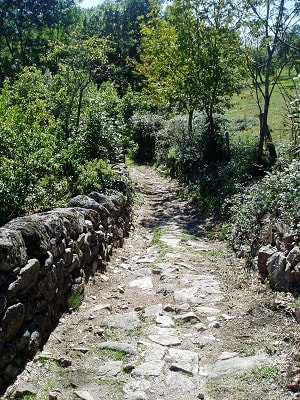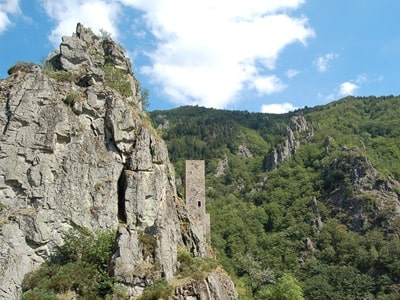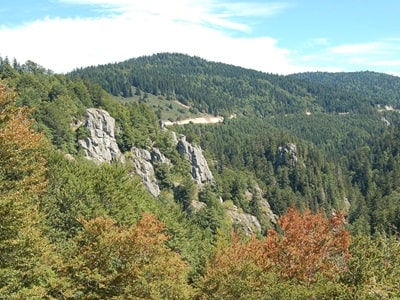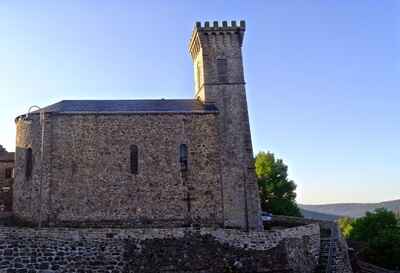History of Loubaresse in Ardèche |

 The Roman road that wound through the mountains and valleys of Vivarais and the Cévennes was more than just a road. It was a vital artery connecting these two regions, promoting commercial, cultural, and military exchanges. Today, it is called the "Roman road trail," and its remains can still be admired along its path. But its exact route remains a mystery, as it has been partly covered by vegetation or altered by humans over the centuries. However, it is known to have crossed the villages of Loubaresse, Saint-Pierre-de-Colombier, Le Cheylard, and Thueyts, where you can still see sections of paved road and stone bridges. The Roman road was used by merchants, travelers, pilgrims, as well as Roman legions occupying the region. The Roman road trail has become a popular hiking route, offering exceptional panoramas and historical testimonies.
The Roman road that wound through the mountains and valleys of Vivarais and the Cévennes was more than just a road. It was a vital artery connecting these two regions, promoting commercial, cultural, and military exchanges. Today, it is called the "Roman road trail," and its remains can still be admired along its path. But its exact route remains a mystery, as it has been partly covered by vegetation or altered by humans over the centuries. However, it is known to have crossed the villages of Loubaresse, Saint-Pierre-de-Colombier, Le Cheylard, and Thueyts, where you can still see sections of paved road and stone bridges. The Roman road was used by merchants, travelers, pilgrims, as well as Roman legions occupying the region. The Roman road trail has become a popular hiking route, offering exceptional panoramas and historical testimonies.
 Middle Ages
Middle Ages
In the 12th century, the landscape of Loubaresse changed radically with the construction of the Loubaresse fortress, which dominated the Ardèche valley. This castle marked the birth of the lordship of Loubaresse, which was under the authority of the Counts of Toulouse. The lords of Loubaresse owed their loyalty and support to the Counts of Toulouse, who protected them and granted them privileges. The lordship of Loubaresse was one of the most powerful in Vivarais. It extended over a vast territory and exercised many feudal rights, such as justice, tax collection, and control of roads and bridges.
The lordship of Loubaresse disappeared during the French Revolution, when the nobles' properties were confiscated and sold. The Loubaresse fortress was built in the 12th century by the La Tour-Saint-Vidal family, who kept it until the 14th century. It then passed into the hands of several noble families, who transformed and expanded it over the centuries, notably in the 14th and 16th centuries. The castle was the seat of the lordship of Loubaresse for more than six hundred years. It was sold as national property during the French Revolution and was later converted into a farm. The Loubaresse fortress is a square-plan castle surrounded by four round towers. It is built of cut stone, with thick walls and narrow windows. It has a keep, which served as residence and defense, an inner courtyard with stables and kitchens, and annex buildings housing servants and soldiers.
 List of lords:
List of lords:
12th-13th centuries: The La Tour-Saint-Vidal family, who gave their name to the castle and lordship.
14th century: The Roquefort family, who inherited the castle through marriage and reinforced it to resist English attacks during the Hundred Years' War.
15th-16th centuries: The La Baume family, who acquired the castle by purchase and modernized it by adding Renaissance-style elements.
17th-18th centuries: The Vogüé family, who succeeded the La Baume family through alliance and beautified the castle with touches of classical style.
19th century: The Chambon family, who bought the castle from the Vogüé family and transformed it into a farm.
 The Abbey of Chambons, located in Borne, was founded in 1152 by Guillaume de Borne, a local lord who wanted to create a place of prayer and charity. He was assisted by his sons, who donated lands and properties to him. The Abbey of Chambons was initially a Dalonite abbey, meaning it followed the Rule of Saint Benedict but with greater autonomy. It later joined the Cistercian order, which advocated a more austere and contemplative life. It was affiliated with the Abbey of Sénanque, which sent monks and goods. The Abbey of Chambons was located at the place called Chambons, in the canton of Saint-Étienne-de-Lugdarès. It included an abbey church, a cloister, a refectory, a dormitory, an infirmary, a library, cellars, barns, and gardens. It also owned lands, mills, forges, and rights over surrounding villages. The Abbey of Chambons was led by regular abbots elected by the monks. Among them were Pierre Geofroi, Bernard I Durand, Pierre II de Merle, Pierre III Adhémar, and others.
The Abbey of Chambons, located in Borne, was founded in 1152 by Guillaume de Borne, a local lord who wanted to create a place of prayer and charity. He was assisted by his sons, who donated lands and properties to him. The Abbey of Chambons was initially a Dalonite abbey, meaning it followed the Rule of Saint Benedict but with greater autonomy. It later joined the Cistercian order, which advocated a more austere and contemplative life. It was affiliated with the Abbey of Sénanque, which sent monks and goods. The Abbey of Chambons was located at the place called Chambons, in the canton of Saint-Étienne-de-Lugdarès. It included an abbey church, a cloister, a refectory, a dormitory, an infirmary, a library, cellars, barns, and gardens. It also owned lands, mills, forges, and rights over surrounding villages. The Abbey of Chambons was led by regular abbots elected by the monks. Among them were Pierre Geofroi, Bernard I Durand, Pierre II de Merle, Pierre III Adhémar, and others.
The Abbey of Chambons reached its peak in the 12th and 13th centuries, when it had about forty monks and a hundred lay brothers who worked for the abbey. It then declined due to wars, epidemics, looting, and reforms. It was abolished during the French Revolution, and its buildings were destroyed or sold. Today, only the ground plan of the abbey church and its walls remain, showing its Latin cross layout, its three naves, its transept, and its choir. Stones from the abbey can also be found reused in the walls of houses in the village of Chambons. The Abbey of Chambons remains a place full of history and memory, attracting curious visitors and enthusiasts.
 The village of Loubaresse was fortified in the 14th century because it was located on the Roman road connecting Vivarais to the Cévennes, a route coveted by the English and French during the Hundred Years' War. The village was surrounded by walls with two gates and watchtowers. The village was also protected by the Loubaresse fortress, which served as a refuge for inhabitants in times of danger. Loubaresse was besieged, plundered, and set on fire several times during the Hundred Years' War, but it resisted bravely. Today, the village still preserves traces of its medieval past, with stone houses, narrow streets, and remnants of fortifications.
The village of Loubaresse was fortified in the 14th century because it was located on the Roman road connecting Vivarais to the Cévennes, a route coveted by the English and French during the Hundred Years' War. The village was surrounded by walls with two gates and watchtowers. The village was also protected by the Loubaresse fortress, which served as a refuge for inhabitants in times of danger. Loubaresse was besieged, plundered, and set on fire several times during the Hundred Years' War, but it resisted bravely. Today, the village still preserves traces of its medieval past, with stone houses, narrow streets, and remnants of fortifications.
Loubaresse experienced a prosperous period from the 16th to 18th centuries thanks to sheep farming and transhumance, which supported the village and its surroundings. Nestled in a green setting at the foot of the mountains, Loubaresse was a major center of sheep breeding. The inhabitants cared for their sheep, which provided wool, meat, and milk. The wool was woven locally or sold to regional manufacturers who made cloth, blankets, and clothing. The meat and milk were processed into local products such as cheese, butter, ham, and sausages.
 Every year, in spring, the shepherds of Loubaresse would take their flocks to the mountains of the Vercors, where they found fresh and abundant grass. The sheep grazed in the alpine pastures during the summer, under the supervision of the shepherds and their dogs. In autumn, the shepherds and their flocks returned to Loubaresse along ancestral paths. Sheep farming and transhumance brought wealth and prestige to Loubaresse. The village developed and beautified, with new stone houses featuring slate or tile roofs. The church was enhanced and enlarged, with a magnificent crenellated bell tower dominating the village. Loubaresse’s prosperity lasted until the 19th century, when sheep farming declined due to competition, diseases, and rural exodus.
Every year, in spring, the shepherds of Loubaresse would take their flocks to the mountains of the Vercors, where they found fresh and abundant grass. The sheep grazed in the alpine pastures during the summer, under the supervision of the shepherds and their dogs. In autumn, the shepherds and their flocks returned to Loubaresse along ancestral paths. Sheep farming and transhumance brought wealth and prestige to Loubaresse. The village developed and beautified, with new stone houses featuring slate or tile roofs. The church was enhanced and enlarged, with a magnificent crenellated bell tower dominating the village. Loubaresse’s prosperity lasted until the 19th century, when sheep farming declined due to competition, diseases, and rural exodus.
The church of Loubaresse, dedicated to Saint Martin, was built in 1845 on the site of an old chapel. It features a magnificent crenellated bell tower, which is actually the remnant of an old tower behind the village. This tower was part of the village fortifications erected in the 14th century to protect against English attacks during the Hundred Years' War. The bell tower was constructed with the remains of a watchtower built by the lord of Borne to oversee the Ardèche valley.
The name Borne comes from the granite rock on which the Château de Borne stood, belonging to the Randon family. It was Guillaume de Randon, lord of Borne, who in 1152 donated part of his lands to Dom Amélius. Dom Amélius was a Cistercian monk who founded the Cistercian Abbey of Chambons on these lands, which became an important spiritual and cultural center in the region. The Château de Borne was located on this rock, which offered breathtaking views of the Tanargue massif, whose highest point is the Grand Tanargue, at 1,511 meters. The Château de Borne was destroyed during the Wars of Religion, and only ruins remain today.
Former holiday hotel with a garden along the Allier, L'Etoile Guest House is located in La Bastide-Puylaurent between Lozere, Ardeche, and the Cevennes in the mountains of Southern France. At the crossroads of GR®7, GR®70 Stevenson Path, GR®72, GR®700 Regordane Way, GR®470 Allier River springs and gorges, GRP® Cevenol, Ardechoise Mountains, Margeride. Numerous loop trails for hiking and one-day biking excursions. Ideal for a relaxing and hiking getaway.
Copyright©etoile.fr